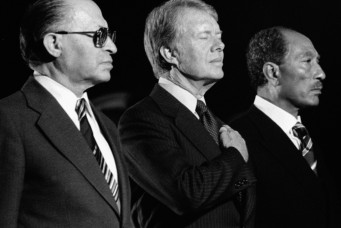Palestine Prevented
Historians should not look for the roots of Israeli state policies and Palestinian oppression in the events of 1967, but in colonial practices leading up to 1948
Preventing Palestine: A Political History from Camp David to Oslo. By Seth Anziska. Princeton University Press, Princeton, NJ, 2018. 435 pp.
In Preventing Palestine: A Political History from Camp David to Oslo, Seth Anziska outlines the political motivations and intentions surrounding negotiations for statehood in Palestine after the 1967 Six-Day War, or al-Naksa (setback). Published in 2018, a year that coincided with a marathon of anniversaries surrounding the Palestinian–Israeli conflict, Anziska paints a dismal picture of what he calls the “genealogy of a non-event.” Through extensive use of recently declassified international documents and interviews with military veterans, community representatives, and engaged diplomats, the reader observes the internal dynamics among Israel, the United States, and Egypt whose interests intersected to ensure that Palestine would never acquire self-determination in the form of a state.
Throughout the text, the story of the organized undermining of both the political leadership and historical demands of the Palestinian people in the period between the 1967 war until the present is told through the lens of power. The priorities of the political leadership of Israel, the United States, and Egypt and their resulting bilateral and trilateral agreements become the terrain upon which Palestinian dispossession is outlined. We are told that participating in twelve days of secret negotiations at Camp David in 1978, Israel’s Menachem Begin sought to solidify military occupation in Jerusalem, the West Bank, and Gaza Strip through the development and increase of Jewish-only settlements. “We have a right and a demand for sovereignty over these areas of Eretz Yisrael [the Land of Israel],” Begin explained in a Knesset speech, “This is our land and it belongs to the Jewish nation rightfully.” Not unlike the present territorial reality in historic Palestine, Begin’s proposal allowed for temporary autonomy for the Palestinian leadership with complete Israeli foreign and military control accompanied by the provision of citizenship, to be eventually followed by a return to Israeli sovereign rule.
Working from the same continuum of national self-interest, and far from the desire to see the establishment of a sovereign Palestinian state, the primary objective of Egyptian President Anwar Sadat was regaining the Israeli-occupied Sinai Peninsula lost during the 1967 war, according to Anziska. Yet, demands of the Arab nationalist movement also compelled Sadat to display solidarity and promote the Palestinian national movement by pushing for at least a “permissible degree of Palestinian self-rule.” While mutually self-serving, the Israeli and Egyptian positions on Palestinian sovereignty did differ: Begin’s model of self-rule “drew on an older colonial discourse of limited self-determination,” whereas Sadat’s position officially promoted a Palestinian state in the West Bank and Gaza Strip only insofar as it did not impede Egyptian territorial interests. Meanwhile, President Jimmy Carter’s “thinking beyond the existing script” of possibilities in Middle East diplomacy nevertheless treated illegal Israeli settlements in occupied Palestinian territories as a catalyst for the autonomy negotiations rather than an impediment.
At a time when geopolitical tension with the Soviet Union led to imperial machinations through satellite states, Israel was robustly placed as a strategic regional ally of the United States, as were wealthy anti-communist Arab states, while the Israeli leadership was able to cast the Palestine Liberation Organization as a broker for Soviet influence in the region. It is particularly telling that upon observing how this (im)balance of power further enshrined occupation and racialized separation, Israeli journalist Amnon Kapeliouk stated that, “South African Bantustans have more prerogative and wider margin of maneuver” than that of the Palestinian leadership. Taken together, the priorities of the three protagonists of the story of Palestinian statehood as outlined by Anziska resulted in Israeli territorial consolidation over occupied lands in the form of administrative councils exclusively for Jewish settlements.
Having explained the perspectives of the three Camp David leaders on Palestinian dispossession and political exclusion, Anziska outlines how the Camp David agreement set the conceptual grounds for the negotiations that have followed since. In line with the legacy of state prevention established by Begin, the exchanges of national self-interest at Camp David led to the normalization of military occupation through the 1979 Egyptian–Israeli peace treaty. Later, the Oslo accords of 1993 reproduced similar asymmetrical power relations between Israel and Palestine while indefinitely deferring final status issues. It was no surprise therefore when, in 1995, the Oslo II agreement granted the newly established Palestinian Authority limited self-government in select racialized zones in the West Bank and Gaza Strip— what Anziska calls “vestiges of statehood without actual content.” Overall, Anziska’s book employs rich detail and extensive research to outline the continuity of power imbalances and colonial reproductions of exclusion within Palestinian–Israeli decision-making processes. That said, the book’s greatest limitation is the intellectual and political starting point adopted by the author. By rooting Palestinian colonial dispossession in the aftermath of the 1967 war, Anziska undermines the colonial, political factors that continue to give shape to life in contemporary Israel/Palestine.
Indeed, the year of the publication of Anziska’s text also marked seventy years since the establishment of the state of Israel, the Palestinian al-Nakba (catastrophe) which resulted in the forced displacement and exile of around 750,000 Palestinians from their homeland. However, if the main features of this catastrophe are the theft of Palestinian land, expulsion of the indigenous community, the imposition of a racialized and oppressive citizenship regime onto the non-Jewish Arabs who were not expelled (the Arab citizens of Israel today), and the implementation of selective military administration, then the Nakba is more than a singular moment in the lead-up to the creation of the “Jewish state.” Far from a discrete episode or a historical event, the Nakba represents a continuity of dispossession, of which events like Camp David, the Oslo accords, the creation of the Palestinian Authority, the 2002 Road Map, and the present-day Trump Peace Initiative are an extension.
As such, it is not continuity among the events after 1967 studied by Anziska that has hitherto prevented the creation of a Palestinian state, but rather, the ongoing process of the Nakba itself. As Palestinian scholar Joseph Massad reminds us, the occupation of Palestinian land is a devastation with a “decidedly planned future ahead of it”—a future that needs to be institutionally maintained and intellectually reproduced. Informed by a settler-colonial ideology that shapes the contemporary Jewish state, practices continue to be employed by Israel to give life to the Nakba. Had he sourced his “genealogy” of the so-called peace process in the Nakba as an ongoing process of dispossession, Anziska would then have been able to discuss Zionist oppression as being intimately tied to the seventy-plus years of the Palestinian–Israeli conflict.
Shourideh C. Molavi is writer and assistant professor of political science at the American University in Cairo. Since 2003, Molavi has written about and been an active participant in numerous Israeli and Palestinian academic institutions, research centers, and civil society coalitions. She has also worked since 2014 as a legal researcher and fieldworker with Forensic Architecture, an independent research agency based at Goldsmiths, University of London.
Read More


